DVelum - PHP + ExtJS4 development platform
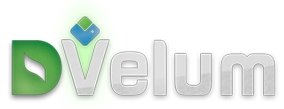 I want to introduce you to a project that will allow you to take a fresh look at the process of developing applications with a web interface.
I want to introduce you to a project that will allow you to take a fresh look at the process of developing applications with a web interface.This is not just another cms or framework, it is a high-performance application development platform, a data management system.
When creating were used non-standard interesting approaches. Nothing beyond the revolutionary, implemented the obvious things that are strongly lacking in frameworks and cms.
The concepts of the system began to be worked out since 2008, in 2011 several different projects in the direction were merged into DVelum.
The reason for the creation of the project was the abundance of developments, the implementation of which could not be found in the open frameworks. These decisions have been tested in difficult combat conditions. After we were able to significantly simplify our lives while developing projects and it became clear that such an approach has the right to life, there was a desire to share ideas with the community.
The project is distributed under the GNU GPL v3 license, is in beta testing, the current version is 0.8.4b.
Project site dvelum.ru
')
Who may be interested in the platform
Anyone involved in web development in PHP. Developers of various systems with web-interfaces, ranging from sites to CRM and ERP.
Those who are not afraid of such words as OOP, design patterns, MVC, ORM, ExtJs4, development managers and leading project developers.
Using DVelum will reduce the number of beginner developers mistakes and headache when reviewing the code, especially ExtJs-interfaces.
Also relieves developers from part of the routine. Perhaps you can connect less experienced and qualified specialists to a complex project by giving them the job of sketching components in the visual interface.
Tasks that the platform solves:
- increase the speed of project development;
- visualization of management and development tools, their close connection with the structure of the project in progress;
- facilitating the life of a programmer, getting rid of routine operations;
- automation of interface development;
- posting project changes; building service packs;
- report building automation;
- organization of versioned data control;
- monitoring the source code of a production-system for external intervention;
- increase in productivity of developed systems.
A detailed description of the platform and features of technological solutions can be found on the official website in the documentation section, or ask a question in the comments.
Key Features
IDE
One of the whales that keeps the system on is the built-in mini IDE, which allows you to construct application interfaces in visual mode. Its main advantage is deep integration into the system, which allows operating intrasystem concepts, interacting with ORM and source code, and it is also easy to extend the functionality with its components.

ORM
The platform uses its own lightweight ORM, moreover, there is a visual interface for managing the data structure, which greatly simplifies development. ORM is able to compare and synchronize the structure of the database, again simplifying the deploy database. Implemented multilingual description of objects. An interactive object dependency diagram is also available.

The question may arise - why we did not use the already ready ORM, for example, Doctrine, the whole point is that we are trying to ensure simplicity of structure and portability. We needed specific capabilities for maximum integration with the integrated IDE. To increase the performance of the frontend, we carried out data sampling in the model, the recording occurs through the ORM.
Version control
The version control system of documents (in this case, the documents are ORM objects) allows you to implement various projects from the publisher site, news feeds to the document management system. The main advantage - ease of use and integration (included by setting one tick, allows you to preview).
Media library
Media Library allows you to manage multimedia content, search, edit and cut images, create previews.
 | 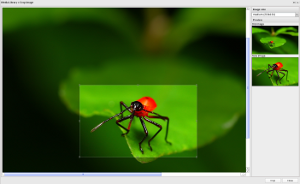 |
Scaffolding
The system at your request can create a CRUD-interface for ORM objects, it is also possible to create a CRUD-interface for objects that are under version control. The peculiarity is that, in addition to the controllers, an IDE project (visual interface) is created, which is then easy to modify at your discretion.
The call of code generation is carried out by means of the visual interface.
Deployment
The system integrates a visual interface for building service packs for production servers. Using the API, the local machine polls the server, gets a file system map, compares it with its own one as a reference, and then offers a list of files to update and delete. The developer chooses which files will be updated, a zip-archive is collected by clicking, which can be unpacked into production.
The publishing system can be used to monitor third-party interference with the source code of your application. The appearance of executable javascript and iframe in the source code of the project is not uncommon, the system will determine the list of modified files.
Reports
The visual report designer allows you to build data samples based on dependencies of ORM objects. Pretty raw but promising module.

Pages
Site structure management module for CMS lovers (framework lovers, can use regular routing controllers).
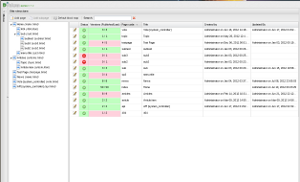 | 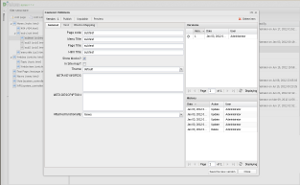 |
 |  |
Performance
The platform offers an optimized kernel for your projects, from which we tried to get the maximum performance.
We very seriously approached the issue of system performance at the design stage, so we managed to achieve a huge separation from most other systems without losing functionality and convenience.
To properly configure your system for maximum performance, use the “Installation and Setup” guide.
Consider the example of the “Blog” functionality test, which has already become a kind of “Hello world” for developers. Framework authors often present the “Blog” functionality as a demo, which we evaluated.
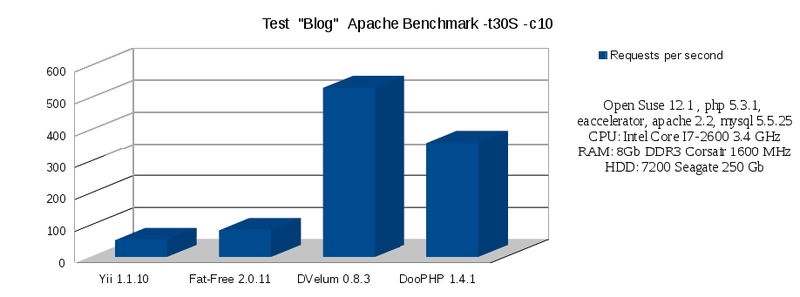
Tested to appeal to the main page of the blog, containing 10 entries.
We carried out quite a lot of tests comparing DVelum with popular CMS, I think publishing them doesn’t make much sense here, because CMS cannot compete in performance in this case.
Of course, it is impossible to judge the quality of the system as a whole only by performance tests; for various reasons, developers do not always pay as much attention to performance as we do. DooPHP (http://doophp.com/benchmark) was a worthy guide in terms of possible performance, we managed to beat it, it was like an entertaining competition. Leng Sheng Hong (by DooPHP), hello to you from Russia.
We do not pursue fashionable technologies, our task is not intricate - to make a quick and convenient toolkit for developers. If necessary, you are able to introduce new items yourself. You can add your favorite libraries by taking them from your favorite framework, for example, the Zend Framework libraries can be easily integrated.
Why did we decide right now to submit the project to the habrasoobshchestvo, because it is still at the beta testing stage? We would like to receive feedback before creating a release candidate, your feedback, suggestions, suggestions, constructive criticism are very important to us.
We hope that the project will be useful, will find a response from the audience and its niche.
In September, we will try to release the first stable version, take into account suggestions and suggestions.
Thank you for reading the article.
I am pleased to answer questions and talk about the features of implementation.
UPD 1:
“Hello World” performance test (source code of the test is available in RC2 demo releases and above)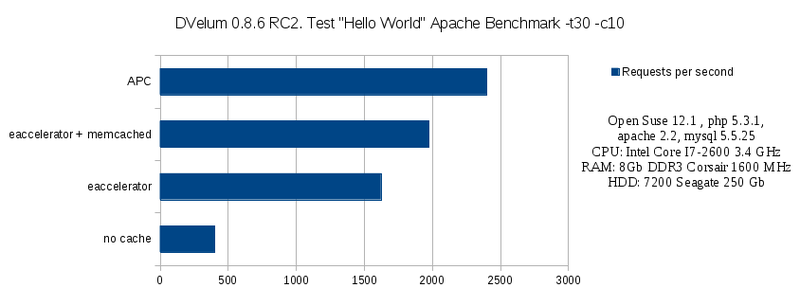
Source: https://habr.com/ru/post/149853/
All Articles